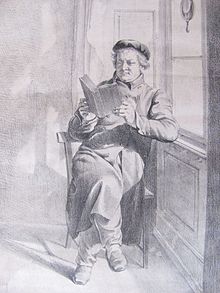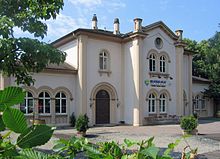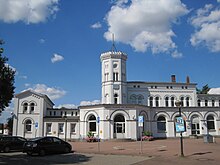Julius Eugen Ruhl
Julius Eugen Ruhl (born October 13, 1796 in Kassel ; † November 27, 1871 there ) was the Hessian court builder and chief building director, academy professor, first general director of the Hessian state railways and consultant for construction in the state's justice and war ministry.
family
Julius Eugen Ruhl was born as the second son of the court sculptor Johann Christian Ruhl , whose family had migrated from Hanau to Kassel a generation earlier . On his mother's side, he was related to Johann Ludwig Völkel (1762–1829), director of the Kassel State Library . His brother was the painter Ludwig Sigismund Ruhl .
education
He received his first school education at the artillery school in Kassel. Engineer officers were also trained there. Mathematics, land surveying, plan drawing, chemistry, German and history were on the curriculum. He also learned how to erase and etch metal plates there, which was very useful to him later when publishing building history documents. The aim of this training was initially a military career in the Electoral Hessian Army .
In 1813/14 Julius Eugen Ruhl took part in the General Staff of Prince Elector Wilhelm II in the Wars of Liberation . Only then did he become a student of the court architect Heinrich Christoph Jussow , who in turn succeeded Simon Louis du Ry in this office . The first drafts for work on Wilhelmshöhe Castle were created . He then received a three-year travel grant to continue his studies in Italy. From June 1817 to May 1819 he studied in Rome, then he stayed in southern Italy and visited Naples , Sicily , Calabria , Salerno , Paestum , Pompeii and Herculaneum . He then traveled to Paris via Florence , Pisa and Genoa . After returning to Kassel from his study trip in 1820, he resumed his studies with Jussow.
Professional career and work
In 1821 he entered the service of the electoral building administration. On February 26, 1823, at the suggestion of his teacher Jussow, Ruhl was appointed court and country architect of the Hanau province. His tasks included the maintenance and construction of public buildings, the urban expansion of the city of Hanau and Bad Nauheim . He caused a stir among his superiors when he refused to erect a scaffold for the public execution of the robbery murderer Peter Kitzler on the market square in Hanau.
The Roman Catholic Church of St. Laurentius in Großkrotzenburg was built by him in the years 1826–1828 under Pastor Philipp Kreisler .
In November 1829 he was transferred to Kassel and in 1831 promoted to chief architect. As early as 1832 he was surprisingly appointed a member of the board of directors of the Academy in Kassel - a part-time position - and immediately got into conflict with the long-established professors. After these escalated, he left in 1840.
When the Electorate of Hesse received a constitution after the July Revolution of 1830 , the construction of a parliament building was necessary - the “ Ständehaus ”. He emerged victorious from the competition advertised for this purpose, and winning this competition also brought him promotion to construction director in 1833. In 1835 he was one of the co-founders of the Kunstverein für Kurhessen . In 1837 he was appointed extraordinary member for construction matters of the Oberhofmarschallamt and the court domain chamber. In 1846 he became a secret advisor for railroad affairs in the cabinet, maintaining his previous employment. This set the focus for his professional activity, from which the majority of his buildings, namely station reception buildings , have been handed down. On July 5, 1850, Elector Friedrich Wilhelm appointed him General Director for State Railways in the Electorate of Hesse. Most of the original station buildings of the Friedrich-Wilhelms-Nordbahn-Gesellschaft , the Main-Weser-Bahn , the Frankfurt-Hanauer Eisenbahn-Gesellschaft (in their Kurhessischen sections) and the railway line Hannover – Minden go back to his designs. He is also familiar with the design for an electoral saloon car .
On October 26, 1853, Ruhl was finally appointed - his predecessor had been retired - as senior building director for the electoral state. At the same time he took over the chairmanship of the superstructure commission and became a consultant for the building industry in the justice and war ministries of the electoral state. At that time he gave up his position on the railroad.
In 1860 he was a co-founder of the "Kurhessischer Architektenverein" (Kurhessischer Architektenverein).
After the Austro-Prussian War , which in 1866 led to the fall of the Electorate of Hesse as an independent state, he was taken over by the Kingdom of Prussia , which annexed the Electorate , as chief building director and ministerial advisor. At the age of 71 he was retired on March 18, 1867.
family
In 1830 he married Marie Gertrude Serruier in Hanau , daughter of a colonel in Dutch service. From the marriage emerged:
- Luise Elisabeth Eugenie Polyxene (1833–1908)
- Johann Philipp Alexander (1815-1830)
- Louis Erwin Julian (1840-1885)
plant

| place | building | Planning and construction time | annotation |
|---|---|---|---|
| Großkrotzenburg | St. Laurentius Church | 1826-1828 | |
| Hanau | Church of Mariae names | 1841-1843 (1850) | badly damaged in a storm during construction in 1843; the extension was carried out according to simplified plans by Johann Caspar Stawitz ; Badly damaged in World War II |
| Bad Nenndorf | St. Godehard Church (ev.) | 1839-1853 | together with Johann Philipp Lichtenberg |
| Volkmarsen | Protestant church | 1839-1847 | |
| Hanau | College house | 1858-1859 | Conversion to barracks, badly damaged in the Second World War, today: Authority building |
| Hanau | Residential house "Noah's Ark" | 1827-1828 | destroyed in World War II |
| Hanau | Customs office at Kanaltorplatz | 1830 | destroyed in World War II |
| kassel | Ständehaus (parliament building) | 1832-1836 | |
| kassel | Ruhl'sches Haus (residential building) | 1834-1842 | destroyed in World War II |
| Hanau | district Court | 1842 | probably from Ruhl; destroyed in World War II |
| Bad Nauheim | Two bath buildings | 1851 | Half-timbered building, formerly bath houses I and II |
| Bad Nauheim | Spa building with casino | 1864-1866 | Badly damaged in the Second World War, significantly changed structurally |
| Bad Nenndorf | Arcade building | 1855 | Extension of the original facility by Simon Louis du Ry |
| Bad Nenndorf | Pump room and concert hall | 1855 | Rebuilt in 1877, demolished in 1959 after a fire |
| kassel | Provisional main train station in Kassel | 1847-1848 | |
| Wahlershausen | Reception building | 1846-1849 | today: Kassel-Wilhelmshöhe; demolished during the construction of the ICE train station |
| Bad Karlshafen train station | Entrance building, left bank | 1847-1849 | Carlsbahn ; demolished before 1972 |
| Helmarshausen station | Reception building | 1847-1849 | today: residential building |
| Trendelburg | Reception building | 1848-1849 | possibly from Ruhl |
| Bahnhof Bahnhof Hümme | Reception building | 1848-1849 | only part of the design was built; Replaced by a new building in 1896 |
| Hofgeismar train station | Reception building | 1846-1848 | |
| Grebenstein | Reception building | 1847-1849 | Ruhl questionable as author; Inoperative in 1873 |
| Guntershausen | Reception building | 1846-1848 | together with G. Tasch |
| Beiseförth | Reception building | 1847-1848 | probably by Ruhl (the documents were burned in the Second World War) |
| Melsungen | Reception building | 1846-1848 | Completely changed in 1895 |
| Rotenburg on the Fulda | Reception building | 1847-1848 | please refer |
| Bahnhof Rotenburg an der Fulda | Reception building | 1847-1848 | please refer |
| Haueda | Reception building | 1847-1848 | Demolished in 1952 |
| Warburg Railway Station (Westphalia) | Reception building | 1850-1853 | |
| Eisenach railway station | Reception building | 1848-1850 | Replaced by a new building in 1904 |
| Gensungen train station | Reception building | 1847-1849 | |
| Wabern railway station | Reception building | 1847-1848 | heavily rebuilt |
| Borken train station | Reception building | 1847-1849 | Destroyed in World War II, illustration in Münzer, p. 56 |
| Zimmerrode train station | Reception building | 1847-1849 | Demolished in 1980; Ruhl's authorship is not clearly established |
| Treysa train station | Reception building | 1847-1849 | Replaced in 1907 by a new building elsewhere, preserved |
| Neustadt train station (Hessen) | Reception building | 1849 | |
| Kirchhain station | Reception building | 1847-1849 | |
| Marburg train station | Reception building ("Champagne station") | 1847-1850 | Replaced by a new building in 1907 |
| Fronhausen | Reception building | 1849 | |
| Lollar train station | Reception building | 1849-1850 | preserved, privatized, not identical to today's reception building from 1879 |
| Bad Nauheim train station | Reception building | 1847-1849 | Replaced by a new building in 1911/13 |
| Bockenheim train station | Reception building | 1851 (?) | replaced by new building; today: Frankfurt (Main) West train station |
| Wilhelmsbad station | Reception building | 1846-1848 | today: Hanau-Wilhelmsbad station |
| Hanau | Reception building | 1846-1848 | tore off; today: Hanau West train station |
| Haste train station | Reception building | 1846-1848 | |
| Lindhorst train station | Reception building | 1846-1847 | |
| Stadthagen train station | Reception building | 1847 | |
| Kirchhorsten station | Reception building | 1846-1847 | |
| Bückeburg train station | Reception building | 1846-1847 |
literature
in alphabetical order by authors / editors
- Gottfried Ganssauge: Julius Eugen Ruhl, senior construction director. In: Ingeborg Schnack (Ed.): Life pictures from Kurhessen and Waldeck 1830–1930. Marburg 1950, pp. 300-310. (= Publications of the Historical Commission for Hesse and Waldeck, 20.4.)
- Ulrike Hanschke: Romantic visions in the “Glorious Eden” - the designs by Kassel architect Julius Eugen Ruhl for Pena Castle in Sintra / Portugal . In: INSITU. Zeitschrift für Architekturgeschichte 1 (2/2009), pp. 91-102.
- State Office for Monument Preservation Hessen (Ed.): Railway in Hessen. Theiss Verlag, Stuttgart 2005, ISBN 3-8062-1917-6 . (= Monument topography Federal Republic of Germany. Cultural monuments in Hesse.)
- Siegfried Lohr : Plans and buildings by the Kassel master builder Julius Eugen Ruhl 1796–1871. A contribution to the building history of Kassel and Kurhessen in the 19th century . Masch. Diss. Darmstadt [1982].
- Siegfried Lohr: Plans and buildings by the Kassel master builder Julius Eugen Ruhl 1796–1871. A contribution to the building history of Kassel and Kurhessen in the 19th century. Darmstadt 1984 = Art in Hesse and the Middle Rhine, Supplement 23.
- Lutz Münzer: traffic and facilities of the northern Main-Weser-Bahn. In: Jahrbuch für Eisenbahngeschichte 32 (2000), pp. 28–60.
- Henning Repetzky: Ruhl, Julius Eugen . In: General Artist Lexicon . The visual artists of all times and peoples (AKL). Volume 100, de Gruyter, Berlin 2018, ISBN 978-3-11-023266-0 , p. 109 f.
Web links
- Portrait of the Railway Director General Julius Eugen Ruhl by Carl Christian Vogel von Vogelstein 1853, Kupferstichkabinett of the Staatliche Kunstsammlungen Dresden .
- Around 440 architectural drawings by Ruhl in the graphic collection of the Hessen Kassel Museum Landscape .
Individual evidence
- ^ Railway in Hessen , Volume 2.1., P. 86.
- ↑ Lucas Mangelmann: Großkrotzenburg. Parish Church of St. Laurentius . In: Church monument preservation in the Diocese of Fulda - annual report 2009. In: Archive for Middle Rhine Church History 62 (2010), pp. 399–414 (408ff).
- ↑ Lohr (1982), p. 221ff.
- ↑ Lohr (1982), p. 238.
- ↑ Lohr (1982), p. 249.
- ↑ Lohr (1982), p. 310f.
- ↑ Lohr (1982), p. 312f.
- ↑ Lohr (1982), p. 314.
- ↑ Lohr (1982), p. 314f.
- ↑ Lohr (1982), pp. 328-332.
- ↑ Lohr (1982), pp. 332f.
- ↑ Lohr (1982), p. 333.
- ↑ Lohr (1982), pp. 334f.
- ↑ Lohr (1982), pp. 335-338.
- ↑ Lohr (1982), pp. 339f.
- ↑ Lohr (1982), p. 340.
- ↑ Lohr (1982), p. 341.
- ↑ Lohr (1982), p. 342.
- ↑ Reinhold Salzmann: On the history of the reception building of Rothenburg an der Fulda 1. In: Around the Alheimer. Contributions to the history and regional studies of the former Rotenburg district 35 (2014), pp. 13–23.
- ↑ Lohr (1982), p. 342.
- ↑ Reinhold Salzmann: On the history of the reception building of Rothenburg an der Fulda 1. In: Around the Alheimer. Contributions to the history and regional studies of the former Rotenburg district 35 (2014), pp. 13–23.
- ↑ Lohr (1982), p. 342.
- ↑ Lohr (1982), pp. 342-344.
- ↑ Lohr (1982), p. 344f.
- ↑ Lohr (1982), p. 346.
- ↑ Lohr (1982), p. 347f.
- ↑ Lohr (1982), pp. 348f.
- ↑ Lohr (1982), p. 349.
- ↑ Lohr (1982), p. 350.
- ↑ Lohr (1982), pp. 351f.
- ↑ Lohr (1982), p. 352.
- ↑ Lohr (1982), pp. 353-356.
- ↑ Lohr (1982), p. 356.
- ↑ Lohr (1982), p. 356.
- ↑ Lohr (1982), p. 357.
- ↑ Lohr (1982), p. 357.
- ↑ Lohr (1982), pp. 357-359.
- ↑ Lohr (1982), p. 359.
- ↑ Lohr (1982), pp. 359-361.
- ↑ Lohr (1982), p. 361.
- ↑ Lohr (1982), pp. 361-363.
- ↑ Lohr (1982), p. 364.
- ↑ Lohr (1982), pp. 364-367.
| personal data | |
|---|---|
| SURNAME | Ruhl, Julius Eugen |
| BRIEF DESCRIPTION | German architect and construction officer from the Electorate of Hesse |
| DATE OF BIRTH | October 13, 1796 |
| PLACE OF BIRTH | kassel |
| DATE OF DEATH | November 27, 1871 |
| Place of death | kassel |












